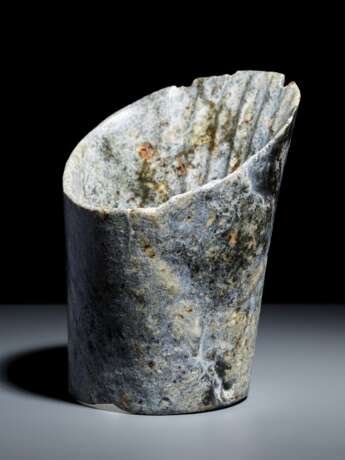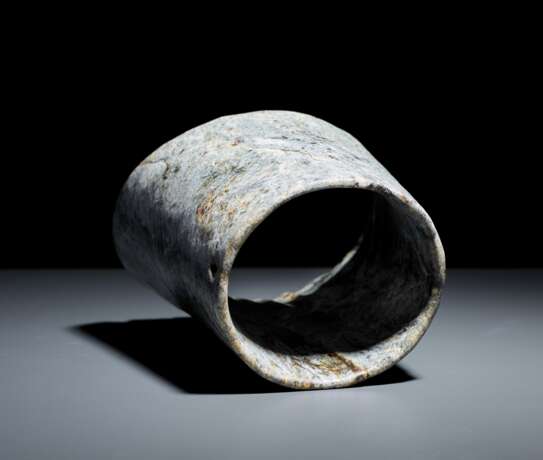ID 933
Lot 40 | SELTEN GROSSER HUFEISENFÖRMIGER TUBUS MATIXING
Estimate value
€ 5 000
Jade
China
Kultur von Hongsha, ca. 3500 - 3000 vor
HÖHE 15,6 CM, UNTERER DM. 8,4 - 9 CM, OBERER DM. 11,5 -13 CM
玉雕馬蹄形件。中國,紅山文化,約公元前3500-3000年。高 15.6 CM, 直徑下 8.4至9 厘米, 直徑上 11.5-13厘米。
Ein besonders großer Tubus mit kräftigst belebter Maserung der Jade und ausgeprägten Altersmerkmalen. Diese röhrenförmigen Stücke sind in der Hongshan-Kultur vermutlich Haarhalter für noble Damen, vielleicht auch Herren gewesen bzw. wurden als Grabbeigaben hinter den Kopf gelegt. Sie wurden aber auch neben dem Körper liegend gefunden. Rawson schreibt in ihrem Buch, daß sich meist nur ein Stück in den Gräbern befunden hat, positioniert im ehemaligen Haarbereich. Die “Hufeisenform” wird Matixing 楔巬⼊ genannt und sie ist für diese “Haarhalter” ganz charakteristisch. Weitere Merkmale sind auf der höheren Innenseite die streifenartigen Kanäle, hier sechs insgesamt und gemäß der Tubus-Form leicht nach außen gebogen. Und die beiden Ösen am unteren Rand dienten vermutlich zur Befestigung am Haar.
An diesem Tubus ist die ungewöhnliche Größe auffällig und sehr beeindruckend, die Person musste überaus volles Haar gehabt haben. Weiters ist das Maserungsspiel kraftvoll belebt und bietet teils fast stürmische Wolkigkeit, zahlreiche Einschlüsse und Adern, das Mineral dürfte eine schwarzgrüne Farbe gehabt haben, ist jedoch aufgrund der Alterung weitgehend weißlich geworden. Die Verwitterung hat an den Rändern Scharten verursacht, die abgesehen von einer etwas größeren mehr klein sind. Die meisten bisher gefundenen Stücke dieser Art wurden in Niuheliang entdeckt, das sich im Nordosten Chinas in der Provinz Liaoning befindet.
Vergleichsbeispiele finden sich in vielen Publikationen, etwa in “Chinese Jades”, Hrsg. Rosemary E. Scott, in Tafel 6 und 7 (textlich wird u. a. bemerkt, daß “Stil der Frisur und Haarzier lange Zeit große Bedeutung hatten für den Rang der Person”. Weiters in “Chinese Jade. Selected Articles ...” in “Orientations”, Hongkong. Oder in “Jades from China”, Museum of East Asian Art, Nr. 27.
Notes by Prof. Salviati: This tubular ornament is carved from a mottled, bluish-greyish type of jade with extensive alterations in the form of white veins and patches that are evenly distributed over the strongly weathered surface. The back side is embellished with smooth, parallel grooves and two small, slightly slanting holes are drilled on the sides and at the bottom. The top edges of these finely crafted jades are thinner in comparison to the rest of the object, hence breakage may easily occur during buriaLänge: in fact, several similar excavated artefacts are chipped along the top edge, such as those recovered from various tombs of the Niuheliang site (Jianping county, Liaoning province) and reproduced in Zhang Shuwei 張樹偉 and Li Xiangdong 李向東 (eds.), Shikong chuanyue: Hongshan wenhua chutu yuqi jing pin zhan 時空穿越:红山文化玉器精品展 (Through time and space: Unearthed jade articles of the Hongshan Culture), Beijing 2012, pp.59-67. See also Yang Xiaoneng (ed.), The Golden Age of Chinese Archaeology. Celebrated Discoveries from The People`s Republic of China, New Haven and London, Yale University Press, 1999, no.11
Expertise: Wolfmar Zacken & Filippo Salviati
Aus einer deutschen Privatsammlung
| Address of auction |
Galerie Zacke Mariahilferstrasse 112 1070 Wien Austria | ||||||||||||||
|---|---|---|---|---|---|---|---|---|---|---|---|---|---|---|---|
| Preview |
| ||||||||||||||
| Phone | +00 4315-320 452 | ||||||||||||||
| Fax | +43-1-5320452-20 | ||||||||||||||
| Buyer Premium | 27.000 | ||||||||||||||
| Conditions of purchase | Conditions of purchase | ||||||||||||||
| Business hours | Business hours
|









